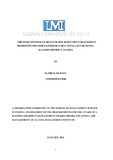| dc.contributor.author | OKWANY, Patrick | |
| dc.contributor.author | t Nuwagaba, Innocen(Supervisor) | |
| dc.contributor.author | Mugurusi, Godfrey(Supervisor) | |
| dc.date.accessioned | 2017-07-21T12:15:30Z | |
| dc.date.available | 2017-07-21T12:15:30Z | |
| dc.date.issued | 2016-01 | |
| dc.identifier.citation | APA | en_US |
| dc.identifier.other | 12/MMSPPM/27/040 | |
| dc.identifier.uri | http://hdl.handle.net/20.500.12305/203 | |
| dc.description | A Dissertation submitted to the Higher Degrees Department in partial fulfillment of the requirements for the award of the Master’s Degree in Management Studies (Project Planning and Management) of Uganda Management Institute | en_US |
| dc.description.abstract | This study assessed the effectiveness of disaster risk reduction strategies in promoting household food security in Palam Sub County, Katakwi district, Uganda. This was necessitated by the fact that there was rampant food insecurity in Palam Sub County after disaster despite NGO and government interventions in disaster risk management. The purpose of the study was to assess the effectiveness of disaster Risk Reduction interventions in promoting household food security in Palam sub County, Katakwi district. The study objectives were; determining the effectiveness of disaster mitigation in promoting Household food security in Palam Sub County, examining the effectiveness of Disaster Preparedness in promoting household food security in Palam Sub County and determining the effectiveness of disaster emergency response in enhancing household food security in Palam Sub County. The target respondents were community households, district and sub county disaster committee members and NGOs involved in DRR. A cross sectional research design was employed with both quantitative and qualitative research methodology. The main instruments for data collection were questionnaire and interview guide. The study population was 2114 and a sample of 197 respondents was selected. The data collected was analyzed using computer software SPSS version 16.0. The study findings showed that disaster mitigation had a strong positive degree of association with household food security. This was indicated by the spearman’s correlation coefficient of 0.727. This implies that when disaster mitigation increases, household food security also increases. There was also a significant positive relationship between disaster preparedness and household food security as was indicated by spearman’s correlation coefficient of 0.708. In addition, there was also a positive significant relationship between emergency response and household food security. This is indicated by the spearman’s correlation coefficient of 0.187. The recommendation was that the Government and NGOs should urgently make DRR a priority if food security is to be achieved in Palam Sub County. | en_US |
| dc.language.iso | en | en_US |
| dc.publisher | Uganda Management Institute | en_US |
| dc.subject | Food Security | en_US |
| dc.subject | Disaster risk | en_US |
| dc.subject | Palam Subcounty | en_US |
| dc.subject | Katakwi District | en_US |
| dc.subject | Uganda | en_US |
| dc.title | The effectiveness of Disaster risk reduction Strategies in Promoting Household Food Security in Palam Subcounty, Katakwi District, Uganda | en_US |
| dc.type | Book | en_US |

